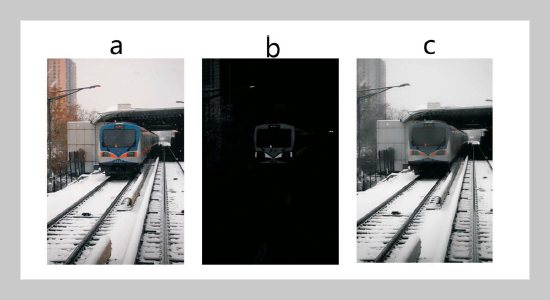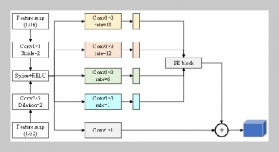REFERENCES
- [1] Garg, K., and S. K. Nayar (2004) Detection and removal of rain from videos, Proceedings of the 2004 IEEE Computer Society Conference on Computer Vision and Pattern Recognition, Washington, DC, USA, June 27–July 2. doi: 10.1109/CVPR.2004.1315077
- [2] Garg, K., and S. K. Nayar (2005) When does a camera see rain? Tenth IEEE International Conference on Computer Vision (ICCV’05), Beijing, China, Oct. 17–21, 1067–1074. doi: 10.1109/ICCV.2005.253
- [3] Dabov, K., A. Foi, V. Katkovnik, and K. Egiazarian (2006) Image denoising with block-matching and 3D filtering, Image Processing: Algorithms and Systems, Neural Networks, and Machine Learning, 6064, 606414. doi: 10.1117/12.643267
- [4] Brewer, N., and N. Liu (2008) Using the shape characteristics of rain to identify and remove rain from video, Joint IAPR International Workshops on Statistical Techniques in Pattern Recognition (SPR) and Structural and Syntactic Pattern Recognition (SSPR), 451–458. Berlin/Heidelberg: Springer. doi: 10.1007/978-3-54089689-0_49
- [5] Barnum, P., T. Kanade, and S. G. Narasimhan (2007) Spatio-temporal frequency analysis for removing rain and snow from videos, Electric Power Components and Systems 46(2), 230–241.
- [6] Barnum, P. C., S. Narasimhan, and T. Kanade (2010) Analysis of rain and snow in frequency space, International Journal of Computer Vision 86(2–3), 256. doi: 10.1007/s11263-008-0200-2
- [7] Bossu, J., N. Hautière, and J.-P. Tarel (2011) Rain or snow detection in image sequences through use of a histogram of orientation of streaks, International Journal of Computer Vision 93(3), 348–367. doi: 10.1007/ s11263-011-0421-7
- [8] Kang, L. W., C. W. Lin, and Y. H. Fu (2011) Automatic single-image-based rain streaks removal via image decomposition, IEEE Transactions on Image Processing 21(4), 1742–1755. doi: 10.1109/TIP.2011.2179057
- [9] Kang, L. W., C. W. Lin, C. T. Lin, et al. (2012), Selflearning-based rain streak removal for image/video,
2012 IEEE International Symposium on Circuits and Systems, Seoul, South Korea, May 20–23, 1871–1874. doi: 10.1109/ISCAS.2012.6271635
- [10] Kim,J.H., C.Lee,J.Y.Sim,etal.(2013) Single-image deraining using an adaptive nonlocal means filter, 2013 IEEE International Conference on Image Processing, Melbourne, VIC, Australia, Sept. 15�18, 914–917. doi: 10.1109/ICIP.2013.6738189
- [11] Liu, G., Z. Lin, S. Yan, et al. (2012) Robust recovery of subspace structures by low-rank representation, IEEE Transactions on Pattern Analysis and Machine Intelligence 35(1), 171–184. doi: 10.1109/TPAMI.2012.88
- [12] Chen, D. Y., C. C. Chen, and L. W. Kang (2012) Visual depth guided image rain streaks removal via sparse coding, IEEE Transactions on Circuits and Systems for Video Technology 24(8), 151–156. doi: 10.1109/ ISPACS.2012.6473471
- [13] Luo, Y., Y. Xu, and H. Ji (2015) Removing rain from a single image via discriminative sparse coding, Proceedings of the IEEE International Conference on Computer Vision, Santiago, Chile, Dec. 7�13, 3397–3405. doi: 10.1109/ICCV.2015.388
- [14] Han, X., Y. Gao, Z. Lu, et al. (2015) Research on moving object detection algorithm based on improved three frame difference method and optical flow, 2015 Fifth International Conference on Instrumentationand Measurement, Computer, Communication and Control (IMCCC), Qinhuangdao, China, Sept. 18–20, 580– 584. doi: 10.1109/IMCCC.2015.420
- [15] Li, Y., R. T. Tan, X. Guo, et al. (2016) Rain streak removal using layer priors, IEEE Conference On Computer Vision and Pattern Recognition, June 27–30, 2736–2744. doi: 10.1109/CVPR.2016.299
- [16] Liu, S., and Y. Piao (2016) A novel rain removal technology based on video image,In SelectedPapers of the Chinese Society for Optical Engineering Conferences, Changchun, China. doi: 10.1117/12.2256439
- [17] Mathew, A., and T. Y. Mahesh (2016) An analytical approach on Haze and rain removal from videos, 2016 International Conference on Emerging Technological Trends (ICETT), Kollam, India, Oct. 21–22, 1–4. doi: 10.1109/ICETT.2016.7873757
- [18] Kaplan, N. H., K. K. Ayten, and A. Dumlu (2017) Single image dehazing based on multiscale product prior and application to vision control, Signal, Image and Video Processing 11(8), 1389–1396. doi: 10.1007/ s11760-017-1097-4
- [19] Wang, Y., S. Liu, C. Chen, et al. (2017) A hierarchical approach for rain or snow removing in a single color image,IEEE Transactions on Image Processing 26(8), 3936–3950. doi: 10.1109/TIP.2017.2708502
- [20] Gu, S., D. Meng, W. Zuo, et al. (2017) Joint convolutional analysis and synthesis sparse representation for single image layer separation, Proceedings of the IEEE International Conference on Computer Vision, Venice, Italy, Oct. 22–29, 1708–1716. doi: 10.1109/ ICCV.2017.189
- [21] Chang, Y., L. Yan, and S. Zhong (2017) Transformed low-rank model for line pattern noise removal, IEEE International Conference on Computer Vision, Venice, Italy, Oct. 22–29, 1726–1734. doi: 10.1109/ICCV. 2017.191
- [22] Yang, T., V. Nsabimana, B. Wang, et al. (2017) Snow fluff detection and removal from video images, IECON 2017-43rd Annual Conference of the IEEE Industrial Electronics Society, Beijing, China, Oct. 29�Nov. 1, 3840–3844. doi: 10.1109/IECON.2017.8216655
- [23] Song, B.C.,andS.J.Seo(2015) Rain detection and removal algorithm using motion-compensated non-local mean filter, Visual Information Processing and Communication VI9410,941006.doi:10.1117/12.2080464
- [24] Peng, L., and B. Li (2018) Single image dehazing based on improved dark channel prior and unsharp masking algorithm, International Conference on Intelligent Computing, 347–358. Cham: Springer. doi: 10.1007/ 978-3-319-95930-6_32
- [25] He, K., J. Sun, and X. Tang (2012) Guided image filtering, IEEE Transactions on Pattern Analysis and Machine Intelligence 35(6), 1397–1409.
- [26] Adler, W. F. (1999) Rain impact retrospective and vision for the future, Wear 233–235, 25–38. doi: 10. 1016/S0043-1648(99)00191-X
- [27] Zheng, X., Y. Liao, W. Guo, et al. (2013) Single-image-based rain and snow removal using multi-guided filter, International Conference on Neural Information Processing, 258–265. Berlin/Heidelberg: Springer. doi: 10.1007/978-3-642-42051-1_33
- [28] Liu, D. F., M. Deng, and D. M. Wang (2013) Background subtraction based on Gaussian mixture model, Advanced Materials Research 694–697, 2021–2026. doi: 10.4028/www.scientific.net/AMR.694-697.2021
- [29] Chen, Y. Q., Z. L. Sun, N. Wang, et al. (2018) Background subtraction with superpixel and k-means, International Conference on Intelligent Computing, 108– 112. Cham: Springer. doi: 10.1007/978-3-319-959337_14
- [30] Wang, Y., S. Liu, C. Chen, et al. (2017) A hierarchical approach for rain or snow removing in a single color image,IEEE Transactions on Image Processing 26(8), 3936–3950. doi: 10.1109/TIP.2017.2708502
















